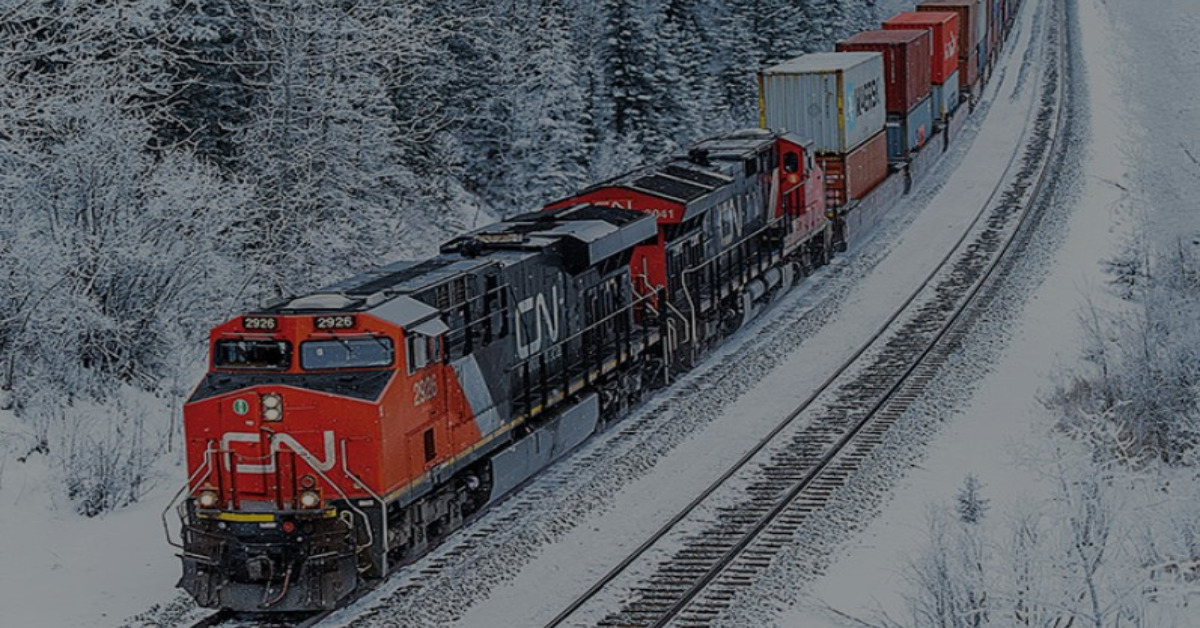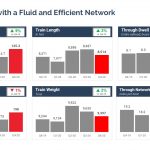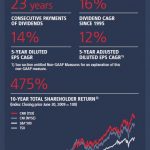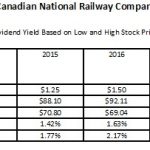Contents
Introduction
A Dividend Champion, defined as a company that has increased its dividend at least 25 consecutive years regardless of whether it is included in the S&P 500 or not, can be a good potential investment to create long-term wealth. Investors, however, must not lose sight of the company’s valuation when acquiring shares. In this article, I look at various valuation metrics which lead me to the conclusion that Canadian National Railway is an overvalued Dividend Champion.
Railroad Industry
The U.S. Department of Transportation Federal Railroad Administration provides a comprehensive Freight Rail Overview. Similar information for Canada can be found on the Government of Canada’s Rail Transportation webpage and also on the Railway Association of Canada (RAC) website.
Class 1 rail carriers in the U.S. have annual revenue of at least $346.8 million in 2006. In Canada, a Class 1 rail carrier has earned gross revenues above $0.25B for each of the previous two years.
In North America the 7 Class 1 rail carriers are:
- BNSF Railway (owned by Berkshire Hathaway) – trackage in Canada and the US
- Union Pacific Railroad – trackage in the US
- Canadian National Railway – trackage in Canada and the US
- CSX Transportation – trackage in Canada and the US
- Norfolk Southern Railway – trackage in Canada and the US
- Canadian Pacific Railway – trackage in Canada and the US
- Kansas City Southern – trackage in the US and Mexico
Canadian National Railway Overview
If you are remotely interested in learning about this company I very strongly recommend you look at the Reports and Archives section of the company’s website where you will find the most recent Annual Report and Investor Fact Book.
Financial Review
Q4 and FY2020 Results
CNR’s most recent Financial Results can be found in its January 26, 2021 Earnings Release and accompanying documents. We see that COVID-19 had a detrimental impact on revenues, diluted and adjusted diluted EPS, operating income, and adjusted return on capital. These metrics all deteriorated relative to FY2019.
Operating Ratio
The operating ratio, a key metric to analyze railroads, is a company’s operating expenses expressed as a percentage of revenue. It is the opposite of operating margin which divides operating income by revenues. We must, however, evaluate a railroad like any other company where we look at revenue growth, strong profit margins, efficient capital deployment, etc.
While a low operating ratio is indicative of a railroad’s efficiency, we must not become too obsessed with lowering the operating ratio as this can lead to long-term issues. If a railroad defers maintenance, sheds locomotives, employees and track-miles this reduces operating expenses and improves the operating ratio. These actions, however, can discourage new business, irritate existing customers and labour partners, adversely impact safety, and attract unwelcome involvement by lawmakers and regulators.
A higher operating ratio can, in fact, deliver better service and improved profits. A railroad, for example, could focus on reducing its operating ratio by straightening track curvature to save fuel expense but then decline to invest in additional track or locomotive power to grow business and revenue because this would increase operating expenses and the operating ratio. As a result, there is a fine balance when it comes to having a low operating ratio.
A good operating ratio is typically in the low to mid 60% range. In FY2019 and 2020, CNR had an operating ratio of 62.5% and 65.4%; after adjustments, the ratio was 61.7% and 61.9%. Management has indicated the adjusted operating ratio is a useful measure of performance to facilitate period-to-period comparisons. This is because they exclude items that do not necessarily arise as part of the company’s normal day-to-day operations and could distort the analysis of trends in business performance. An explanation of the adjustment used to arrive at the adjusted operating ratio is found on page 7 of 18 in the Q4 Earnings Release.
Other Key Efficiency Metrics
Other key FY2019 and FY2020 efficiency metrics such as freight revenue per carload, train weight and length, car velocity, and locomotive utilization are found on page 5 of 18 in the Q4 Earnings Release. The following is a snapshot of key metrics for the past few quarters.
Free Cash Flow (FCF)
On a positive note, CNR generated FCF of $3.227B. This compares favorably with 2014 – 2019 levels of $2.22B, $2.373B, $2.52B, $2.778B, $2.514B, and $1.992B.
Looking at the company’s historical ability to generate strong FCF we see there is an ample margin of safety to meet its:
- annual mandatory capital expenditures;
- debt repayment;
- dividends;
- share repurchases.
Financial Guidance
Management has indicated the recovery remains uneven across the markets served. The company’s full-year financial outlook, however, is reinstated since there is an increase in volume demand and increased optimism about FY2021. In FY2021, plans are for:
- ~$3.0B of capital investments to stay ahead of demand and to keep meeting customer needs through safe and efficient operations;
- EPS growth in the high single-digit range compared to adjusted diluted EPS of C$5.31 in FY2020;
- FCF of $3B – $3.3B versus $3.2B in FY2020;
- Mid-single digit volume growth in terms of revenue ton-miles (RTMs) is also being targeted.
Risk Assessment
A schedule of CNR’s debt obligations can be found on page 27 of 51 in the Full Year Financial Statements found in the Financial Results of the company’s website.
The major credit rating agencies undertake a comprehensive review of a company and assign a risk rating. I use these ratings to gauge if my risk as an equity investor is reasonable.
Moody’s has rated the unsecured long-term debt A2 since August 2014 and S&P Global has assigned an A rating since December 2013. Both ratings are the middle tier of the upper-medium grade investment-grade category. These ratings indicate CNR has a STRONG capacity to meet its financial commitments. It is, however, somewhat more susceptible to the adverse effects of changes in circumstances and economic conditions than obligors in higher-rated categories.
The current ratings are satisfactory for my risk profile.
Dividends and Dividend Yield
Looking at this Dividend Champion’s stock information we see dividend history is reflected only as far back as 2011. The company, however, prides itself on its long track record and in the Investors section of the company’s website, there is a 2019 Investor Fact Book in which page 5 of 53 specifically references the company’s commitment to long-term value creation that includes the distribution of dividends. Furthermore, page 14 of the Q4 2020 Analyst Presentation found in the 2020 tab in the Financial Results section of the Investors segment of the website indicates the company’s 25-year track record of uninterrupted dividend growth.
On January 26, 2021, CNR announced a ~7% increase in its quarterly dividend to $0.6150 from $0.575. This new dividend will commence with the March 31 dividend payable to shareholders of record at the March 10 close of business.
The $2.46 in 2021 dividend payments will yield ~1.7% based on the current ~$142 share price.
Let’s compare this Dividend Aristocrat’s historical dividend yield with the ~1.7% forward dividend yield. We see the forward dividend yield is similar to historical levels when the company’s share price was closer to the annual stock price ‘highs’ versus the ‘lows’.
A comparison between the current and historical dividend yields suggests Canadian National Railway is an overvalued Dividend Champion.
With the impact of COVID-19 being unknown, CNR decided to pause its share repurchases in Q2 2020 and indicated this method of rewarding shareholders would be reassessed on an ongoing basis.
Management has recently stated that it expects to resume share repurchases in Q1. In fact, the company’s Board of Directors has authorized the purchase, for cancellation, over a 12-month period of up to 14 million common shares, representing 2.36% of the ~594 million common shares issued and outstanding not held by insiders on January 18, 2021; ~711.7 million common shares were outstanding on that date.
The average number of diluted shares outstanding (in millions) during 2014 – 2020 has steadily declined: 823.5, 805.1, 779.2, 757.3, 737.7, 722.6, and 713; FYE2021 share count will likely be ~700 million shares.
Valuation
We can see from CNR’s long-term track record that an investment in this company allows investors to ‘sleep well’. We need to determine, however, if the current valuation will enable us to generate an attractive investment return.
Management has forecast FY2020 $5.31 adjusted diluted EPS to grow by a high single-digit. Using a 7 – 9% increase we get a ~$5.68 – $5.79 range. Also, FY2021 guidance from 24 brokers is a mean of $5.96 and a low/high range of $5.58 – $6.20. Erring on the side of caution I use the $5.74 mid-point of management’s guidance. Based on the current ~$142 share price, the forward adjusted diluted PE is ~24.74.
Looking at the valuation based on FCF, management has provided FY2021 guidance of $3B – $3.3B. Being conservative I will use $3B for valuation calculation purposes.
As noted earlier, I forecast ~700 million shares will be outstanding at FYE2021. On this basis, we get an average of ~706 million shares outstanding in FY2021. Divide $3B of FCF by 706 million shares to arrive at $4.25 of FCF per share. Shares are trading at ~$142 giving us an FY2021 Price/FCF estimate of ~33.4.
The valuation based on FY2021 estimates suggests the current valuation is more similar to when shares were trading at the upper end of the historical stock price range.
A comparison between the current and historical valuation metrics suggests Canadian National Railway is an overvalued Dividend Champion.
Conclusion
In conclusion, I view Canadian National Railway as an overvalued Dividend Champion. In my opinion, a price of ~$118 or lower is more reasonable. At this level, the forward adjusted PE is ~20.6, and the forward Price/FCF per Share is ~27.8.
The ~1.7% dividend yield is closer to the historical yield when the share price was closer to the 52-week high. If the share price retraces to ~$118, the $2.46 dividend will yield ~2.1%. This is somewhat similar to when shares were trading at the 52-week low.
There appears to currently be an element of irrational exuberance and I view CNR’s current share price as elevated. If we get a broad market price pullback, CNR’s stock price will get caught up in the downdraft so I am prepared to bide my time for a better valuation.
I wish you much success on your journey to financial freedom.
Thanks for reading!
Note: Please send any feedback, corrections, or questions to charles@financialfreedomisajourney.com.
Disclaimer: I do not know your individual circumstances and am not providing individualized advice or recommendations. I encourage you not to make any investment decision without conducting your own research and due diligence. You should also consult your financial advisor about your specific situation.
I wrote this article myself and it expresses my own opinions. I do not receive compensation for it and have no business relationship with any company mentioned in this article.
Disclosure: I and long Canadian National Railway in the FFJ Portfolio.






